The Nikolaiviertel or St. Nicholas Quarter is a small neighborhood in the historic center of Berlin. It is the site of Berlin’s founding and home to the city’s oldest church, the Nikolaikirche.
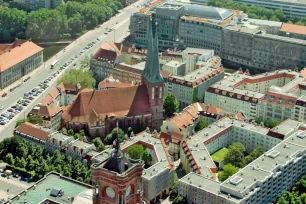
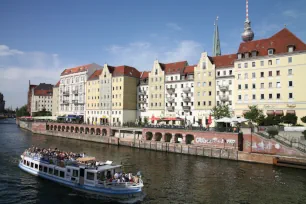
Nikolaiviertel occupies the area where Berlin was first founded in the early thirteenth century. The neighborhood’s narrow and often pedestrianized streets are very popular with tourists. The area, which borders the Spree river, contained some of the oldest buildings in Berlin before it was turned into wasteland at the end of the Second World War.
Recreating a Historic District
After the war, Nikolaiviertel became part of East-Berlin. It wasn’t until 1979, in the run-up to the 750th anniversary of the city, before reconstruction of the area started.
During the eight-year project, replicas of historic buildings were constructed in an attempt to recreate a historic quarter. It was sometimes scornfully nicknamed ‘Honecker’s Disneyland’ due to the unorthodox way in which the restoration took place. Almost none of the buildings were built at their original location. The result is nonetheless a nice tourist-attracting area with many restaurants and cafés.
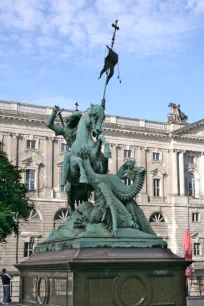
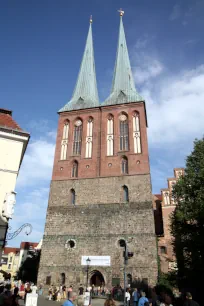
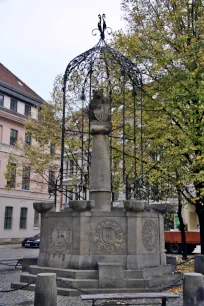
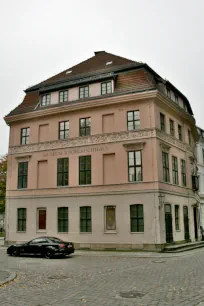
Sights
Nikolaikirche
At the center of the Nikolaiviertel is the oldest church in Berlin: the Nikolaikirche, which gave the quarter its name. The church dates all the way back to the early days of Berlin. It was probably built shortly after Berlin was granted town privileges. The building has undergone much reconstruction over the centuries. A presbytery was built in 1402 and the two towers were added in 1877.
The Nikolaikirche was destroyed in 1945 by bombing and completely rebuilt in 1987. The church now houses a museum recounting the history of the city.
Wappenbrunnen
In front of the church is the charming Nikolaikirchplatz, a small square with a medieval looking fountain known as the Wappenbrunnen (Coat of arms fountain). The fountain was created in 1987 after a design by Gerhard Thieme from 1928. On each side of the octagonal fountain is a relief showing a coat-of-arms. In the middle of the fountain is a column on which a bear statue rests. The bear symbolizes the city of Berlin. The fountain commemorates the founding of the city, hence it is also known as the Gründungsbrunnen (fountain of the founding).
The city’s founding is also remembered with a more than two meter wide memorial medallion on the pavement in front of the Nikolaikirche. It shows the original seal of the city of Berlin. The medallion commemorates the year 1230 when Berlin first received town privileges, granting it autonomy.
Knoblauchhaus
Right near the Nikolaikirche stands the Knoblauchhaus, a house in Rococo style that miraculously survived the war almost unscathed. It was built in 1759-1761 as the residence for Johann Christian Knoblauch, whose family owned the house until 1929, when it was sold to the city of Berlin. The facade received a neoclassical makeover in the early nineteenth century.
The building was thoroughly restored on the occasion of Berlin’s 750th anniversary. Today it is a museum, giving you the rare opportunity to visit a Berliner house with authentic nineteenth-century furniture.
Gerichtslaube
The Gerichtslaube is a reconstruction of Berlin’s medieval courthouse. It was originally built in 1270 in Gothic style with arcades and was integrated into Berlin’s town hall. The building was demolished in 1871 during the construction of the Rotes Rathaus, the new city hall. The Gothic structure was rebuilt in Babelsberg, a park in Potsdam. When the Nikolaiviertel was recreated in the 1980s, it was decided to build a replica of the Gerichtslaube here, about 150 meters (500ft) from its original location.
Ephraim Palace

On the edge of Nikolaiviertel stands the Ephraim-Palais. This beautiful Rococo palace was built in 1766 for Veitel Ephraim, a court jeweler and owner of gold and silver manufacturers. The palace was demolished in 1938 to make way for a new bridge. In 1985-1987 it was rebuilt on a plot close to the original site of the palace. Today the building is used for temporary exhibitions.
Statue of St. George
The largest monument in Nikolaiviertel is a statue of St. George fighting the dragon. The statue was created in 1853 by the German sculptor August Kiss and originally adorned a courtyard of the Stadtschloss, the majestic Berlin city palace. It now occupies a spot on a small square near the river Spree.
- Next: Siegessäule
- More Sights & Attractions in Berlin

